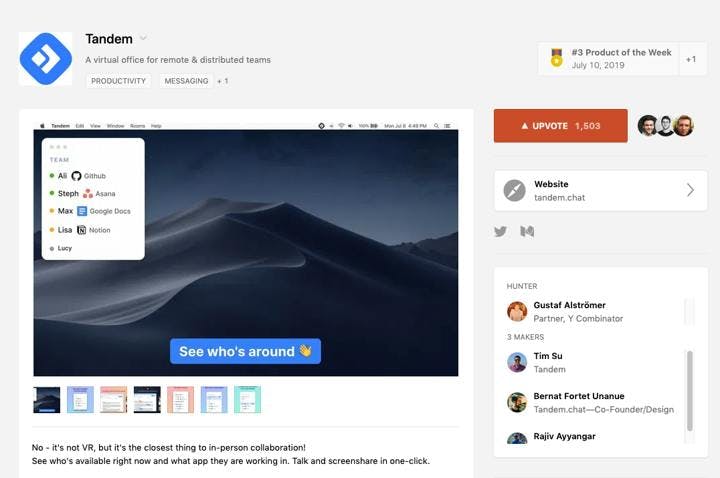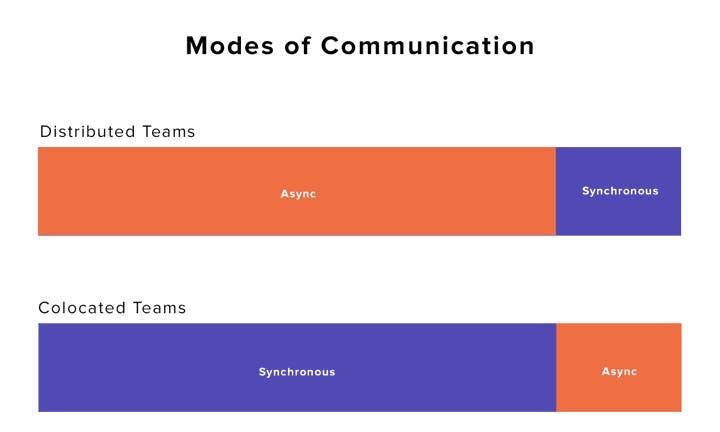Remote teams don't need a virtual office

Quick Note: This post is a response to this HN article I read a few minutes ago.
My first job working remotely was back in 2013. Our remote work tool stack was Hipchat (as this was before Slack launched), Google Docs, Asana, Hangouts, and this tool called Sqwiggle.
For those unaware, Sqwiggle was a virtual office for distributed teams. You'd boot up the software, it would start your webcam, and you'd join a digital workspace alongside your coworkers.
As you worked, you could look up and see what your coworkers were doing and they could do the same. A day in the life of a remote worker is pretty boring - lots of staring at a screen. But if you wanted to talk, you could click and instantly jump into a conversation with someone else.
As an employee, I hated this for a variety of reasons.
The first reason was that my computer struggled running a video call all_day_long (just imagine a loud whirring fan constantly). I always had to stay plugged-in too, otherwise my battery would die.
The second reason was that this felt like an employee oversight tool. While the intention was to make it easy to sync up with coworkers, it always felt like the tool was best used to make sure people were in front of their desk, working.
We used the tool for a month or two before we ditched it. The company later shut down in 2016.
2016-2019: A quiet period
For a few years, interest in the virtual office seemed to be flat, even as remote work continued to grow in popularity.
I still worked remotely at this time, but the consensus seemed to be that Zoom and Slack were suitable tools. After all, if you wanted a synchronous conversation, you could join a call in 15-30 seconds with the /zoom slash command.
Sure, remote employees still missed the water-cooler conversations that the office provided, but the technology continued to get better. At least video calls were not freezing constantly like back in 2013.
2019: The rebirth of the virtual office and the hype cycle
This Summer, I was wasting time on Twitter and saw a new tool called Tandem, which was dubbed as "a virtual office for remote teams." After a couple minutes, I concluded (maybe too quickly) that this was Sqwiggle 2.0. The functionality was a bit different, but the principle was the same in my mind.
Instead of seeing your coworkers staring at a screen all day on video, you could see the apps that they were working in instead. A new level of employee oversight is now unlocked!

A couple of weeks later, I saw this article by Kevin Kwok called the Arc of Collaboration, which I strongly recommend you read. The premise of the post is that Slack is where you go when your processes fall apart (true).
In my view, he correctly points out the need for a abstraction layer for collaboration tools and outlines how this problem might be solved using a tool that functions like Discord:
"Beyond its Slack-like functionality, Discord has functionality like a social graph, seeing what games your friends are playing, voice chat, etc. These have been misunderstood by the market. They aren’t random small features. They are the backbone of a central nervous system."
Starting to sound familiar?
"Active users of Discord have it on all the time, even when they are not playing games. It’s a passive way to have presence with your friends. And when your friends start playing games it makes it easy to with one click go join them in the game."
At this point, you may be starting to connect the dots. A virtual office tool like Tandem could be this meta layer. If this thesis is true, there may be a Slack sized opportunity here.
It turns out, that's pretty much what happened. Tandem ended up raising a massive round of funding, which kicked the hype cycle into high gear.
Nowadays, I've seen several startups pursuing this idea of a virtual water-cooler for distributed teams. While I wish them the best, I don't think remote work needs to replicate the office.
The office is not the gold-standard of how work should be done.
Remote work doesn't need to replicate the office
In the rest of the post I will lay out reasons why I am not a fan of these virtual office tools. Then I will talk about how you can recreate the "water-cooler effect" with your team.
I want to be clear - I have zero issues with other startups building tools for distributed workers. I have friends working on this problem. My disagreement is with their approach. I'm sure the people working on these products are nice and friendly.
The rising tide lifts the boats, including mine. However, I have a different perspective based on several years of experience actually working remotely (many of these virtual office startups do not even work remotely on a day-to-day basis), but that's another topic for another day.
1.) Asynchronous is what makes remote work...work
The #1 benefit of distributed work is the ability to do the majority of work asynchronously. At Friday, I have two internal meetings every week (both one-on-ones). The rest is asynchronous.
Instead of having a ton of synchronous conversations/meetings all day long, remote work is based around the principle of flexibility. This could be the ability to work when you are most productive (for example, I started writing this blog post at 5:30am). Another example could be the flexibility of living in a different timezone than your coworkers.
This is only possible when you teams work asynchronously by default. Two people do not need to be working at the same time for work to happen on a distributed team...at least most of the time. I wrote more about the difference in this article about how distance changes the way we communicate.
2.) Limited upside
If people like working asynchronously and this is the main "mode of work" for distributed teams, any virtual office that makes synchronous conversations better is going to capture a limited amount of upside. If 20% of a remote worker's day is spent communicating synchronously, any improvement is going to have a limited impact on their day. After all, this is not their default mode of communicating.

Additionally, there's a variety of tools focused on making real-time conversations better (Zoom, Google Hangouts, BlueJeans, etc). I use Zoom regularly for ad-hoc conversations and think it works fine. I don't feel like I need another tool. Maybe I'm biased or a remote-work Luddite?
3.) Most people don't like the office, why replicate it?
I won't spend a lot of time on this next point, but for the life of me, I don't understand why the idea of a virtual office sounds appealing. Anything related to the office makes many remote workers cringe. The research is pretty clear - people hate open-offices and before that, people hated cubicles too.
Why are we trying to recreate an environment that people don't like?
4.) It can be used as an employee control tool
Tools like the virtual office glue you to your desk and inadvertently replicate the feeling of "butts in seat." This is how I felt back in 2013 with Sqwiggle. Remote work at its best frees you from this way of working, as your output is what matters most.
This reminds me of the problems people have with Slack presence/status/do not disturb. What happens if the CEO tries to jump into your "virtual office" and you are out taking the dog for a walk? Is it okay that you were away? Should you be online all the time?
There are better ways to create remote team accountability vs. requiring that people be present all day long for "collaboration."
5.) It's distracting
I love the fact that most days, I can spend hours actually doing work vs. the constant chatter. While I really enjoy my coworkers and will talk with them anytime, I also love ending my day feeling like I made substantial progress. The idea of someone being able to jump in at any moment in time and "knock on my door" sounds terrible.
A few weeks ago, we met up in person and worked from a coffee shop in Nashville. It was a fun time, but I wouldn't be successful if this was the default default way of working. I need the long stretches of time to get things done.
"But we miss out on water-cooler conversations working remotely!"
I agree.
As a remote worker, it can difficult to get to know coworkers on a personal level. What is their favorite color? Did they watch [insert show] on Netflix last weekend?
Some people who work remotely downplay the benefits of getting to know others by making comments like, "I don't need to be best friends with my coworkers."
While I agree with the principle that you don't need to be BFFs, getting to know others on a personal level is a helpful reminder that the people you work with are more than words on a screen. You can't ignore the human aspect of working with others. I don't think setting up a Slack channel for water-cooler discussion is cutting it either.
There is a water-cooler problem when working remotely, but I don't believe the answer is an "always-on" tool like the virtual office.
Recreating the water-cooler while balancing async work
The question is - how do you create the "water-cooler effect" (which is just a code-word for getting to know others) as a distributed team?
I have a few quick suggestions:
- Have company meetups on a regular basis. There is no replacement for face-to-face-interaction.
- As a leader, have regular one-on-one meetings - this is a great way to learn a bit more about each person that reports to you.
- Have a time-boxed virtual "coffee shop" session. This is my best advice on creating the water cooler effect . Read the full post on this topic here.
Dedicate time for water-cooler conversations
After hanging out with coworkers in-person, I thought it would be fun to allocate one hour every couple of weeks to jump on a Zoom call and "pretend" like we were all working together at a coffee shop. I've seem other remote companies do Zoom calls like this, but they wouldn't be working and instead would do ice-breaker questions. This felt a little cheesy to me.
This water-cooler event would be time-boxed and we'll still do work on the call, but the goal of the meeting was not to be highly productive, but to have some time for chatter while working....just like if we were sitting next to each other.
I loved this format and coworkers seemed to enjoy it as well. I learned new things about coworkers, just like if I was going out to lunch with them at the office.
In conclusion
This post is a philosophical view on how I believe remote work should be conducted. As someone who thinks distributed work will continue to grow in popularity, I want to help other companies be successful.
I'm unconvinced that this will happen by creating a virtual office.


